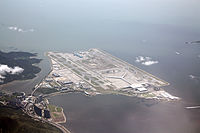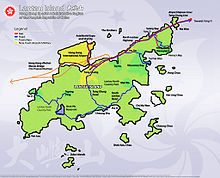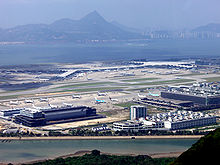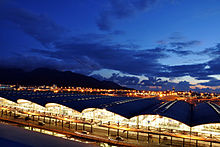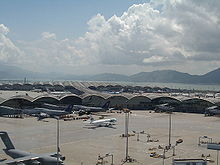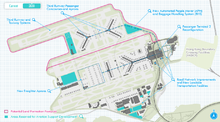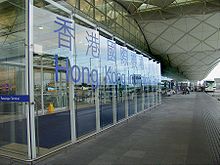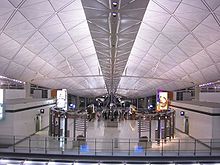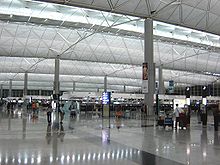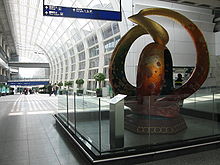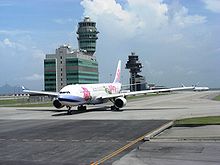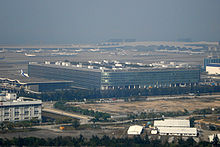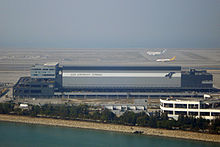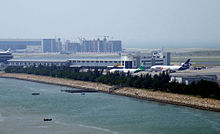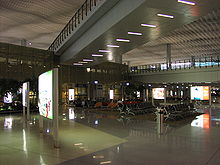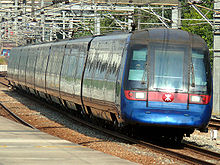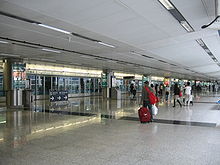- Hong Kong International Airport
-
"HKIA" redirects here. HKIA may also refer to Hong Kong Institute of Architects.
Hong Kong International Airport
Chek Lap Kok Airport
香港國際機場
赤鱲角機場
IATA: HKG – ICAO: VHHH Summary Airport type Public Operator Airport Authority Hong Kong Serves Hong Kong Location Chek Lap Kok, Hong Kong Hub for - Air Hong Kong
- Cathay Pacific Airways
- Dragonair
- Evergreen International Airlines
- Hong Kong Airlines
- Hong Kong Express Airways
- UPS Airlines[1]
Elevation AMSL 28 ft / 9 m Coordinates 22°18′32″N 113°54′52″E / 22.30889°N 113.91444°ECoordinates: 22°18′32″N 113°54′52″E / 22.30889°N 113.91444°E Website Map Location within Hong Kong Runways Direction Length Surface ft m 07R/25L 12,467 3,800 Asphalt 07L/25R 12,467 3,800 Asphalt Statistics (2010) Passengers 50,348,960 ACI[2] Hong Kong International Airport Traditional Chinese 香港國際機場 Simplified Chinese 香港国际机场 Transcriptions Mandarin - Hanyu Pinyin Xiānggǎng Guójì Jīchǎng Cantonese (Yue) - Jyutping hoeng1 gong2 gwok3 zai3 gei1 coeng4 - Yale Romanization Syang1 gang3 Gwo2 ji4 Ji1 chang3 Chek Lap Kok Airport Traditional Chinese 赤鱲角機場 Simplified Chinese 赤鱲角机场 Transcriptions Mandarin - Hanyu Pinyin Chìliè Jiǎo Jīchǎng Cantonese (Yue) - Jyutping cek3 laap6 gok3 gei1 coeng4 - Yale Romanization Chr4 lye4 Jyau3 Ji1 chang3 Hong Kong International Airport (IATA: HKG, ICAO: VHHH) is the main airport in Hong Kong. It is colloquially known as Chek Lap Kok Airport (赤鱲角機場), being built on the island of Chek Lap Kok by land reclamation, and also to distinguish it from its predecessor, the closed Kai Tak Airport.
The airport opened for commercial operations in 1998, replacing Kai Tak, and is an important regional trans-shipment centre, passenger hub and gateway for destinations in Mainland China (with over 40 destinations) and the rest of Asia. Hong Kong International Airport has won eight Skytrax World Airport Awards for customer satisfaction in eleven years.[3][4] HKIA ranked second and third in 2009 and 2010 respectively for the Skytrax World Airport Awards, and has also won the Skytrax World Airport of the Year 2011.
HKIA also operates one of the world's largest passenger terminal buildings (the largest when opened in 1998) and operates twenty-four hours a day. The airport is operated by the Airport Authority Hong Kong and is the primary hub for Cathay Pacific, Dragonair, Hong Kong Express Airways, Hong Kong Airlines and Air Hong Kong (cargo). The airport is also one of the Asian-Pacific cargo hubs for UPS Airlines.[1] It is a focus city for many airlines, including China Airlines and Air New Zealand,[5] and to a lesser extent Qantas and Virgin Atlantic, both of which use Hong Kong as a stopover point for flights on the Kangaroo Route between Australasia and Europe. Both Continental Airlines and Air India use Hong Kong as a stopover point for flights respectively from the United States to Singapore and Ho Chi Minh City as well as from India to Osaka and Seoul. In the near future, Garuda Indonesia is considering making Hong Kong their transit hub for flights to Europe while Swiss International Air Lines considers Hong Kong to be a major transfer hub for its network.[6][7]
HKIA is an important contributor to the Hong Kong economy, employing 60,000. About 90 airlines operate flights from the airport to over 150 cities across the globe. In 2010 HKIA handled 50,348,960 passengers, making it the 11th busiest airport worldwide by passenger traffic.[8] It also surpassed Memphis International Airport to become the world's busiest airport by cargo traffic.[9]
Contents
History
Chek Lap Kok Airport was designed as a replacement for the former Hong Kong International Airport (commonly known as Kai Tak Airport) originally built in 1925. Located in the densely built-up Kowloon City District with a single runway extending into Kowloon Bay, Kai Tak had only limited room for expansion to cope with steadily increasing air traffic. By the 1990s, Kai Tak had become one of the world's busiest airports – it far exceeded its annual passenger and cargo design capacities, and one out of every three flights met delays, largely due to lack of space for aircraft, gates, and a second runway.[10] In addition, noise mitigation measures restricted nighttime flights, as severe noise pollution (exceeding 105 dB(A) in Kowloon City) was estimated to adversely affect at least 340,000 people.[11][12]
A 1974 planning study by the Hong Kong Civil Aviation and Public Works department identified the small island of Chek Lap Kok, off Lantau Island, as a possible airport replacement site. Away from the congested city centre, flight paths would be routed over the South China Sea rather than populous urban areas, enabling efficient round-the-clock operation of multiple runways. Construction of the new airport, however, did not begin until 1991. The construction period was very rushed; specialists considered only a 10–20 year period was sufficient for this massive project. Another cause for this rush was due to the uncertain future of the airport construction after the transfer of sovereignty of Hong Kong to the People's Republic of China. It was originally believed that Beijing preferred to keep everything basically intact and minimise financial commitments for big projects, therefore stopping all construction despite the need for the new airport. At last, the airport did not finish in time for the Handover. However, China gave an additional year's grace period to finish the project. It was finished just in time.[13][14]
Hong Kong International Airport was built on a large artificial island, formed by levelling Chek Lap Kok and Lam Chau islands (3.02 km² and 0.08 km² respectively), and reclaiming 9.38 km² of the adjacent seabed. The 12.48 km² airport site added nearly 1% to Hong Kong's total surface area, connecting to the north side of Lantau Island near Tung Chung new town.[15]
Construction of the new airport was only part of the Airport Core Programme, which also involved construction of new road and rail links to the airport, with associated bridges and tunnels, and major land reclamation projects on both Hong Kong Island and in Kowloon. The project is the most expensive airport project ever, according to Guinness World Records. Construction of the new airport was voted as one of the Top 10 Construction Achievements of the 20th Century at the ConExpo conference in 1999.[16]
The sides of the terminals, predominantly glass, were designed to break during high speed winds, relieving pressure and allowing the terminal to withstand an intense typhoon.[13]
Opened on 6 July 1998, a week later than the new Kuala Lumpur International Airport, it took six years and US$20 billion to build. On that day at 6:25 am, Cathay Pacific flight 889 was the first commercial flight to land at the airport, pipping the original CX292 from Rome which was the scheduled first arrival. The architects were Foster and Partners. However, on the first day of opening, the airport had already started to experience some technical difficulties. The flight information display system (FIDS) had suddenly shut down which caused long delays. Shortly afterwards, the cargo communication link with Kai Tak, where all the data was stored, went down. In the same period of time, someone had accidentally deleted a critical database for cargo services. This meant that cargo had to be manually stored. At one point, the airport had to turn away freight headed for and exported from Hong Kong (except food and medical supplies) while it sorted out the mess. HKIA simply could not keep up without an automated computer assisting.[13] For three to five months after its opening, it suffered various severe organisational, mechanical and technical problems that almost crippled the airport. Computer glitches were to blame for the crisis. Lau Kang-way, a Hong Kong politician, was quoted saying "This was meant to be a first-class project, but it has turned into a ninth-class airport and a disgrace. Our airport has become the laughing stock of the world.[17][18] At one time, the government reopened the cargo terminal at Kai Tak Airport to handle freight traffic because of a breakdown at the new cargo terminal, named Super Terminal One (ST1).[19] However, after six months the airport started to operate normally.
Officially opened in June 2007, the second airport terminal, called T2, (check-in facility only) is linked with the MTR Airport Express on a new platform. The terminal also features a new shopping mall, SkyPlaza, providing a large variety of shops and restaurants, together with a few entertainment facilities. T2 also houses a 36-bay coach station for buses to and from mainland China and 56 airline check-in counters, as well as customs and immigration facilities.
Besides T2, the SkyCity Nine Eagles Golf Course has been opened in 2007 whereas the second airport hotel, the Hong Kong SkyCity Marriott Hotel; and a permanent cross-boundary ferry terminal, the SkyPier, began operations in 2008 and 2009 respectively. Development around T2 also includes the AsiaWorld-Expo which has started operation in late 2005.[20] A second passenger concourse, the North Satellite Concourse (NSC), opened in 2010.
Future Development
In June 2010, the Airport Authority unveiled plans to develop in stages the vast midfield site of the airport island. Stage 1 will involve the construction of a new 20 gate passenger concourse to be built in 2 phases (completion 2015 and 2020) with 11 gates in phase 1 growing to 20 gates in phase 2. Configuration of the new concourse is similar to those at Hartsfield-Jackson Atlanta International Airport, London Heathrow Terminal 5 and Seoul Incheon airport. After stage 1 of midfield development is completed in 2020, there will be sufficient lands remaining for further new concourses to be built as and when demand for them materialises.[21]
Master Plan 2030
One year after, on 2 June 2011, the Airport Authority announced and released their latest version of a 20-year blueprint for the airport's development, the Hong Kong International Airport Master Plan 2030 to the public.[22] The study took three years and according to the authority, nine consulting organizations have been hired for the research, observation, planning and advice. The main focus is to improve the overall capacity and aircraft handling ability of the airport. Based on this, two plans have been made into options for public consultation:
Option 1: Two-runway system
To maintain the current two-runway system, while there will be enhancements to the terminal and apron facilities to increase the airport's capacity. This option will enable the airport to handle a maximum of 420,000 flight movements per year, with annual passenger and cargo throughput increased to 74 million and six million tonnes respectively. The approximate cost of this plan is $23.4 billion Hong Kong Dollars in price of 2010, or HK$42.5 billion considering at money-of-the-day prices. It will increase number of direct jobs associated with HKIA to 101,000 by 2030 (from 62,000 in 2008) and generate a total of HK$432 billion (in 2009 dollars) in economic net present value (ENPV) over a 50-year lifespan up to 2061. However, the Airport Authority estimates that the airport will reach its maximum runway capacity sometime around 2020 if no extra runway is being added.
Option 2: Three-runway system
This plan will focus on developing a third runway to the north of the Chek Lap Kok, the existing island the airport is built on, by land reclamation of about 650 hectares. The associated facilities - additional terminals, airfield and apron facilities will be built accordingly, and combined with the new runway, it is estimated that the airport would be able to handle a maximum of 620,000 flights per year (102 per hour), and meet forecast annual passenger and cargo throughput of about 97 million and 8.9 million tonnes by 2030 respectively.
There are possible drawbacks. Development costs are a concern: although the proposal would increase the number of direct jobs associated with HKIA to 141,000 by 2030 and generate an ENPV of HK$912 billion (in 2009 dollars) over a 50-year lifespan up to 2061, the estimated cost is approximately $86.2 billion (2010) Hong Kong Dollars, or HK$136.2 billion (at money-of-the-day prices). There are also environmental and local noise pollution concerns.
Composition
The airport has a total of 70 boarding gates,[23] with 63 jet bridge gates and seven virtual gates which are used as assembly points for passengers, who are then ferried to the aircraft by apron buses. Of the 63 jet bridges, five are capable of handling the Airbus A380. Singapore Airlines, Emirates and Korean Air currently deploy A380s to Hong Kong and use those gates.
Terminal 1
Terminal 1 of the HKIA is currently the third largest airport passenger terminal building in the world (570,000 m²), after Dubai International Airport's Terminal 3 (1,500,000 m²) and Beijing Capital International Airport's Terminal 3 (986,000 m²[24]).
At its opening, Terminal 1 was the largest airport passenger terminal building, with a total gross floor area of 550,000 m². It briefly conceded the status to Bangkok's Suvarnabhumi Airport (563,000 m²) when the latter opened on 15 September 2006, but reclaimed the title when the East Hall was expanded, bringing the total area to its current size (the East Hall expansion included a 39,000 m² expansion to SkyMart, a shopping mall). Terminal 1's title as the world's largest was surrendered to Beijing Capital International Airport Terminal 3 on 29 February 2008.
Terminal 2
Terminal 2 (140,000 m²), together with the Skyplaza, opened on 28 February 2007 along with the opening of the Airport Station's Platform 3.[25] It is only a check-in and processing facility for departing passengers with no gates or arrival facilities (passengers are transported underground to gates at Terminal 1). So far a majority of low-cost carriers and some full-service carriers have relocated their check-in operations to T2. The SkyPlaza is situated within Terminal 2. Architecture firm Skidmore, Owings and Merrill designed Terminal 2 and the SkyPlaza.[26][27]
North Satellite Concourse
In 2007, HKIA began the construction of a two-storey North Satellite Concourse (NSC) which opened in December 2009. This concourse was designed for narrow-body aircraft and is equipped with 10 jet bridges. The concourse has a floor area of 200,000 m² and will be able to serve more than five million passengers annually. There is a shuttle bus service between the NSC and Terminal 1 every four minutes. The concourse was commissioned at the end of 2009.[28]
Midfield Concourse
Due to commence construction in the third quarter of 2011 and finished by the end of 2015, a new 'midfield concourse' will be built between the two runways. This will include 20 aircraft parking stands, three of these will be wide enough to serve the Airbus A380, and cater for an additional 10 million passengers annually. Passengers will reach the concourse through an extension of the underground ‘automated people mover’ – a driverless train system which serves Terminal 1, Terminal 2 and the SkyPier ferry terminal which provides a ferry service to mainland China.[29]
Other buildings
Cathay Pacific City (Traditional: 國泰城, Simplified: 国泰城, Cantonese: gwok3 taai3 sing4, Mandarin: Guótài Chéng), the head office of Cathay Pacific, is located on the airport property.[30] Dragonair House, the head office of Dragonair, is also on the airport property.[31] The head office of Hong Kong Airlines is on Level 2 of the CNAC House (中航大廈, Cantonese: jung1 hong4 daai6 ha6, Mandarin: Zhōngháng Dàshà) at HKIA.[32][33]
Airlines and destinations
Airlines Destinations Terminal Aeroflot Moscow-Sheremetyevo 1 Air Busan Busan 1 Air Canada Toronto-Pearson, Vancouver 1 Air China Beijing-Capital, Chengdu, Chongqing, Dalian, Tianjin 1 Air France Paris-Charles de Gaulle 1 Air India Delhi, Osaka-Kansai, Seoul-Incheon 1 Air Mauritius Mauritius 1 Air New Zealand Auckland, London-Heathrow 1 Air Niugini Port Moresby 1 Air Pacific Nadi 1 AirAsia Kota Kinabalu, Kuala Lumpur, Penang 2 Airphil Express Cebu 2 All Nippon Airways Nagoya-Centrair, Osaka-Kansai, Tokyo-Haneda 1 All Nippon Airways
operated by Air JapanTokyo-Narita 1 Asiana Airlines Busan, Seoul-Incheon 1 Bangkok Airways Koh Samui 2 Biman Bangladesh Airlines Dhaka 1 British Airways London-Heathrow 1 Cathay Pacific Abu Dhabi, Adelaide, Amsterdam, Auckland, Bahrain, Bangkok-Suvarnabhumi, Beijing-Capital, Brisbane, Cairns, Cebu, Chennai, Chicago-O'Hare, Colombo, Delhi, Denpasar/Bali, Dubai, Frankfurt, Fukuoka, Ho Chi Minh City, Jakarta-Soekarno-Hatta, Jeddah, Johannesburg, Karachi, Kuala Lumpur, London-Heathrow, Los Angeles, Manila, Melbourne, Milan-Malpensa, Moscow-Domodedovo, Mumbai, Nagoya-Centrair, New York-JFK, Osaka-Kansai, Paris-Charles de Gaulle, Penang, Perth, Riyadh, Rome-Fiumicino, San Francisco, Sapporo-Chitose, Seoul-Incheon, Shanghai-Pudong, Singapore, Surabaya, Sydney, Taipei-Taoyuan, Tokyo-Haneda, Tokyo-Narita, Toronto-Pearson, Vancouver 1 Cebu Pacific Cebu, Clark, Manila 1 China Airlines Jakarta-Soekarno-Hatta, Kaohsiung, Taipei-Taoyuan 1 China Eastern Airlines Fuzhou, Hangzhou, Hefei, Jinan, Kunming, Nanchang, Nanjing, Ningbo, Shanghai-Hongqiao, Shanghai-Pudong, Shijiazhuang, Taiyuan, Wenzhou, Wuxi, Xi'an 1 China Southern Airlines Beijing-Capital, Changchun, Guangzhou, Guilin, Meixian, Nanning, Shantou, Shenyang, Wuhan, Zhanjiang, Zhengzhou 1 Continental Airlines Guam, Ho Chi Minh City, Newark, Singapore, Tokyo-Narita 1 Delta Air Lines Detroit, Tokyo-Narita 1 Dragonair Bangalore, Beijing-Capital, Busan, Changsha, Chengdu, Chongqing, Dhaka, Fukuoka, Fuzhou, Guangzhou, Hangzhou, Hanoi, Kaohsiung, Kathmandu, Kota Kinabalu, Kunming, Manila, Nanjing, Ningbo, Naha, Phnom Penh, Phuket, Qingdao, Sanya, Shanghai-Hongqiao, Shanghai-Pudong, Taipei-Taoyuan, Wuhan, Xiamen
Seasonal: Sendai1 El Al Tel Aviv-Ben Gurion 1 Emirates Bangkok-Suvarnabhumi, Dubai 1 Ethiopian Airlines Addis Ababa, Bangkok-Suvarnabhumi 1 EVA Air Taipei-Taoyuan 1 Finnair Helsinki 1 Fly Guam
operated by Sky King, Inc.Seasonal: Saipan 2 Garuda Indonesia Denpasar/Bali, Jakarta-Soekarno-Hatta, Surabaya 1 Hong Kong Airlines Bangkok-Suvarnabhumi, Beijing-Capital, Changsha, Denpasar/Bali, Guilin, Hangzhou, Hanoi, Kunming, London-Gatwick [begins 8 March 2012],[34] Moscow-Sheremetyevo, Phuket, Sanya, Shanghai-Hongqiao, Shanghai-Pudong, Singapore, Tokyo-Narita 1 Hong Kong Express Airways Beijing-Capital, Chengdu, Chongqing, Haikou, Harbin, Manila, Nanning, Naha, Osaka-Kansai, Sanya, Sapporo-Chitose [resumes 30 November], Shanghai-Pudong, Taichung 1 Japan Airlines Tokyo-Haneda, Tokyo-Narita 1 Jeju Air Busan, Seoul-Incheon 1 Jetstar Asia Airways Singapore 2 Jet Airways Delhi, Mumbai 2 Jin Air Seoul-Incheon 1 Juneyao Airlines Shanghai-Pudong 2 Kenya Airways Bangkok-Suvarnabhumi, Nairobi 1 Kingfisher Airlines Delhi, Mumbai 2 KLM Amsterdam 1 Korean Air Busan, Cheongju, Seoul-Incheon 1 Lufthansa Frankfurt, Munich 1 Malaysia Airlines Kota Kinabalu, Kuala Lumpur, Kuching 1 Mandarin Airlines Kaohsiung, Taichung 1 Mega Maldives Gan, Malé 1 MIAT Mongolian Airlines Ulan Bator 1 Nepal Airlines Kathmandu 1 Orient Thai Airlines Bangkok-Suvarnabhumi 1 Pakistan International Airlines Bangkok-Suvarnabhumi, Islamabad, Lahore 1 Philippine Airlines Manila 2 Qantas Brisbane, London-Heathrow [ends 24 March], Melbourne, Perth, Sydney 1 Qatar Airways Doha 1 Royal Brunei Airlines Bandar Seri Begawan 1 Royal Jordanian Amman-Queen Alia, Bangkok-Suvarnabhumi 2 S7 Airlines Khabarovsk [begins 30 March], Vladivostok 2 Saudi Arabian Airlines Jeddah, Riyadh 1 Shanghai Airlines Shanghai-Hongqiao, Shanghai-Pudong, Xuzhou 1 Shenzhen Airlines Quanzhou 2 Sichuan Airlines Beihai, Chengdu, Yichang 1 Singapore Airlines San Francisco, Singapore 1 South African Airways Johannesburg 2 South East Asian Airlines Clark 2 Spring Airlines Shanghai-Pudong, Shijiazhuang 2 SriLankan Airlines Bangkok-Suvarnabhumi, Colombo 1 Swiss International Air Lines Zürich 1 Tianjin Airlines Tianjin 2 Thai AirAsia Bangkok-Suvarnabhumi, Phuket 2 Thai Airways International Bangkok-Suvarnabhumi, Phuket, Seoul-Incheon 2 Tiger Airways Singapore 2 Transaero Airlines Seasonal: Moscow-Domodedovo 1 Turkish Airlines Istanbul-Atatürk 1 United Airlines Chicago-O'Hare, San Francisco 1 Vietnam Airlines Hanoi, Ho Chi Minh City 1 Virgin Atlantic Airways London-Heathrow, Sydney 1 Vladivostok Air Vladivostok 2 Xiamen Airlines Xiamen, Wuyishan 1 Cargo
Airlines Destinations ACT Airlines Cebu, Dhaka, Lahore, Port Moresby, Taipei-Taoyuan Aeroflot-Cargo Almaty, Karaganda, Khabarovsk, Moscow-Sheremetyevo, Novosibirsk Aerologic Bahrain, Brussels, Dubai, Frankfurt, Lahore, Leipzig/Halle, Sharjah Air Atlanta Icelandic Bagram, Kabul, Karaganda, Frankfurt Air Cargo Germany Delhi, Dubai, Hahn, Karaganda, Mumbai, Novosibirsk Air China Cargo Beijing-Capital, Tianjin Air France Cargo Bahrain, Dammam, Dubai, Jeddah, Kuwait, Paris-Charles de Gaulle Air Hong Kong Bangkok-Suvarnabhumi, Beijing-Capital, Manila, Nagoya-Centrair, Osaka-Kansai, Penang, Seoul-Incheon, Shanghai-Pudong, Singapore, Taipei-Taoyuan, Tokyo-Narita AirBridgeCargo Airlines Almaty, Amsterdam, Clark, Ekaterinburg, Frankfurt, Krasnojarsk, Moscow-Domodedovo, Moscow-Sheremetyevo, St Petersburg ANA Cargo Nagoya-Centrair, Naha, Osaka-Kansai, Tokyo-Narita Aryan Cargo Express Bangkok-Suvarnabhumi, Mumbai Asiana Cargo Seoul-Incheon Atlas Air Abu Dhabi, Adana Incirlik, Anchorage, Ault Field, Bagram, Baku, Chicago-O'Hare, Dover, Dubai, Eielson AFE, Fairfield, Guam, Hahn, Huntsville, Iwakuni, Kadena, Kagoshima, Karaganda, Kuwait, Luxembourg, Mazari, Melbourne-Tullamarine, Miami, New York-JFK, Osaka-Kansai, Osan, Sapporo-Chitose, Seoul-Incheon, Sydney, Toledo Avient Aviation Karachi British Airways World Cargo Atlanta, Bahrain, Barcelona, Chennai, Cologne/Bonn, Dammam, Delhi, Dhaka, Dubai, Frankfurt, Karachi, London-Stansted, Mumbai, Munich, Nagoya-Centrair, Osaka-Kansai, Sendai, Singapore, Zaragoza Cardig Air Bangkok-Suvarnabhumi Cargoitalia Dubai, Milan-Malpensa, Sharjah Cargolux Abu Dhabi, Almaty, Amman-Queen Alia, Baku, Barcelona, Beirut, Budapest, Chicago-O'Hare, Dammam, Doha, Dubai, Ferihegy, Helsinki, Ho Chi Minh City, Karaganda, Komatsu, Kuwait, Los Angeles, Luxembourg, New York-JFK, Nuernberg, Riyadh, Singapore, Taipei-Taoyuan, Upington Cargolux Italia Almaty, Dubai, Milan-Malpensa, Osaka-Kansai Cargo Garuda Indonesia Jakarta Cathay Pacific Cargo Amsterdam, Anchorage, Atlanta, Bangalore, Brussels, Chengdu, Chennai, Chicago-O'Hare, Chongqing, Dallas/Fort Worth, Delhi, Dhaka, Dubai, Frankfurt, Hanoi, Ho Chi Minh City, Houston-Intercontinental, Jakarta-Soekarno-Hatta, London-Heathrow, Los Angeles, Manchester, Melbourne, Miami, Milan-Malpensa, Mumbai, New York-JFK, Osaka-Kansai, Paris-Charles de Gaulle, Penang, San Francisco, Seoul-Incheon, Shanghai-Pudong, Singapore, Stockholm-Arlanda, Sydney, Taipei-Taoyuan, Tokyo-Narita, Toronto-Pearson, Vancouver, Xiamen, Zaragoza China Airlines Cargo Manila, Taipei-Taoyuan China Cargo Airlines Qingdao, Shanghai-Pudong DETA Air JSC Almaty DHL Air UK Delhi, Leipzig/Halle Emirates SkyCargo Chennai, Dubai, Kabul, Lahore Ethiopian Airlines Cargo Addis Ababa, Chennai Etihad Crystal Cargo Abu Dhabi EVA Air Cargo Taipei-Taoyuan Evergreen International Airlines Adana Incirlik, Anchorage, Bagram, Chicago-O'Hare, Columbus, Dallas/Fort Worth, Fairbanks, Los Angeles, Marana, Memphis, Nagoya-Centrair, New York-JFK FedEx Express Almaty, Anchorage, Delhi, Manila, Memphis, Osaka-Kansai, Seoul-Incheon, Taipei-Taoyuan, Tokyo-Narita Hong Kong Airlines Cargo Bangkok-Suvarnabhumi, Brussels, Chengdu, Chennai, Delhi, Frankfurt, Hangzhou, Hanoi, Ho Chi Minh City, Osaka-Kansai, Jakarta-Soekarno-Hatta, Ningbo, Penang, Qingdao, Shanghai-Pudong, Singapore, Tokyo-Haneda, Tokyo-Narita, Tianjin, Xiamen, Zhengzhou Jett8 Airlines Singapore Kalitta Air Anchorage, Astana, Bagram, Bahrain, Brussels, Chicago-O'Hare, Cincinnati-Northern Kentucky, Columbus, Dallas, Delhi, Kabul, Kadena, Khabarovsk, Los Angeles, Nagoya-Centrair, Newark, New York-JFK, Rio De Janeiro, Seoul-Incheon KLM Cargo
operated by Martinair CargoAlmaty, Amsterdam, Moscow-Sheremetyevo Korean Air Cargo Seoul-Incheon Lufthansa Cargo Almaty, Bahrain, Bangkok-Suvarnabhumi, Cairo, Chennai, Doha, Frankfurt, Hanoi, Jeddah, Kandahar, Karachi, Leipzig/Halle, Mumbai, Riyadh, Sharjah, Tashkent Martinair Cargo Almaty, Amsterdam, Bahrain, Bangkok-Suvarnabhumi, Chennai, Delhi, Doha, Dubai-Al Maktoum, Muscat, Sharjah MASkargo Kuala Lumpur, Manila, Penang Midex Airlines Kolkata MNG Airlines Cargo Delhi Nippon Cargo Airlines Osaka-Kansai, Tokyo-Narita Nordic Global Airlines Helsinki Polar Air Cargo Anchorage, Bahrain, Campinas-Viracopos, Chicago-O'Hare, Cincinnati-Northern Kentucky, Leipzig/Halle, Los Angeles, New York-JFK, Seoul-Incheon, Wilmington Polet Airlines Ashgabat, Dhaka, East Midlands, Liège, Moscow-Sheremetyevo, Novosibirsk Qantas Freight Geelong, Melbourne, Sydney Qatar Airways Cargo Doha Saudi Arabian Airlines Cargo Dammam, Jeddah, Riyadh, Thiruvananthapuram Shanghai Airlines Cargo Shanghai-Pudong Shenzhen Donghai Airlines Chengdu, Shenzhen, Wuhan Singapore Airlines Cargo Amsterdam, Anchorage, Atlanta, Bangalore, Brussels, Chennai, Chicago-O'Hare, Dallas/Fort Worth, Don Miguel, Hanoi, Los Angeles, Osaka-Kansai, Mumbai, Shanghai-Pudong, Sharjah, Singapore, Sydney, Tokyo-Narita Southern Air Amsterdam, Anchorage, Bangkok-Suvarnabhumi, Chicago-O'Hare, Dubai, Frankfurt, Maastricht, Miami, Mohammed V Int'l, Rio de Janeiro, Seoul-Incheon, Sharjah Star Airlines - Macedonia Karachi TNT Airways Almaty, Hahn, Kabul, Karaganda, Liège Transmile Air Services Anchorage, Johor Bahru, Kuala Lumpur, Riverside, Subang Tri-MG Intra Asia Airlines Cebu, Clark Turkish Cargo Almaty, Istanbul-Atatürk ULS Cargo Bangkok-Suvarnabhumi, Beijing-Capital, Manila, Nagoya-Centrair, Osaka-Kansai, Penang, Seoul-Incheon, Shanghai-Pudong, Singapore, Taipei-Taoyuan, Tokyo-Narita UPS Airlines Anchorage, Clark, Cologne/Bonn, Dubai, Honolulu, Louisville, Mumbai, Ontario, Osaka-Kansai, Philadelphia, Sapporo-Chitose, Seoul-Incheon, Singapore, Sydney, Taipei-Taoyuan, Wilmington World Airways Adana Incirlik, Anchorage, Chicago-O'Hare, Ciudad Del Este, Jeddah, Lagos, Los Angeles, Seoul-Incheon, Sharjah, Yoff Yangtze River Express Hangzhou, Qingdao, Shanghai-Pudong, Tianjin, Zhengzhou Operations
Operations and Statistics year Passenger
movementsAirfreight
movements
(tonnes)Aircraft
movement1998 28,631,000 1,628,700 163,200 1999 30,394,000 1,974,300 167,400 2000 33,374,000 2,240,600 181,900 2001 33,065,000 2,074,300 196,800 2002 34,313,000 1,637,797 206,700 2003 27,433,000 2,642,100 187,500 2004 37,142,000 3,093,900 237,300 2005 40,740,000 3,402,000 263,500 2006 44,443,000 3,580,000 280,000 2007 47,783,000 3,742,000 295,580 2008 48,582,000 3,627,000 301,000 2009 45,499,604 3,440,581 273,505 2010 50,410,819 4,112,416 306,535 Capacity Passenger (current) 50,000,000 Passenger (ultimate) 87,000,000 Cargo (current) 3m tonnes Cargo (ultimate) 9m tonnes Apron (current) 96 Number of destinations International (air) 154 International (water) 6 The airport is operated by the Airport Authority Hong Kong, a statutory body wholly owned by the Government of Hong Kong Special Administrative Region. The Civil Aviation Department (CAD) is responsible for the provision of air traffic control services, certification of Hong Kong registered aircraft, monitoring of airlines on their compliance with bilateral Air Services Agreements and the regulation of general civil aviation activities.
The airport has two parallel runways, both of which are 3800 metres in length and 60 metres wide, enabling them to cater to the next generation of aircraft. The south runway has been given a Category II Precision Approach, while the north runway has the higher Category IIIA rating, which allows pilots to land in only 200 metre visibility. The two runways have an ultimate capacity of over 60 aircraft movements an hour. The Airport is upgrading ATC and runways so that they can handle 68 movements per hour. Normally, the north runway (07L/25R) is for landing passenger planes. The south runway (07R/25L) is for passenger planes taking off and cargo flights due to its proximity to the cargo terminal.
There are 49 frontal stands at the main passenger concourse, 28 remote stands and 25 cargo stands. Five parking bays at the Northwest Concourse are already capable of accommodating the arrivals of the next generation of aircraft. A satellite concourse with 10 frontal stands for narrow body aircraft has been commissioned to the north of the main concourse at the end of 2009, bringing the total number of frontal stands at the airport to 59.
The airport was the third busiest for passenger traffic in Asia in 2010, and the world's busiest airport for cargo traffic in 2010. In terms of international traffic, the airport is the third busiest for passenger traffic and the busiest for cargo since its operation in 1998. There are over 95 international airlines providing about 900 scheduled passenger and all-cargo flights each day between Hong Kong and some 160 destinations worldwide. About 76 percent of these flights are operated with wide-bodied jets. There are also an average of approximately 31 non-scheduled passenger and cargo flights each week.[35]
The operation of scheduled air services to and from Hong Kong is facilitated by air services agreements between Hong Kong and other countries. Since the opening of HKIA, the Hong Kong Special Administrative Region Government has implemented a policy of progressive liberalisation of air services with the intention of promoting consumer choice and competition. Many low-cost airlines have started various regional routes to compete head-on with full-service carriers on trunk routes.
The airport's long term expansion opportunities are subject to variables. An HKD 80 billion proposal to build a third runway has been under feasibility study and consultation but would be very expensive as it would involve additional reclamation from deep waters, and the building cost of the third runway may be as high as the building cost of the entire airport. On the other hand, there exists only one airway between Hong Kong and mainland China, and this single route is often and easily backed up causing delays on both sides. In addition, China requires that aircraft flying the single air route between Hong Kong and the mainland must be at an altitude of at least 15,000 feet. Talks are underway to persuade the Chinese military to relax its airspace restriction in view of worsening air traffic congestion at the airport. Other than that, Hong Kong Airport Authority is cooperating with other airports in the area to relieve air traffic and in the future, Shenzhen may act as a regional airport while Hong Kong receives all the international flights.
Air traffic
The Government Flying Service provides short and long range search and rescue services, police support, medical evacuation and general purpose flights for the Government.
Passenger facilities
The airport is one of the most accessible in operation today. Despite its size, the passenger terminal is designed for maximum convenience. A simple layout and effective signage, moving walkways and the automated people mover allow quick and easy movement throughout the building. The airport also features the HKIA Automated People Mover, a driverless people mover system consisting of 3 stations to provide fast transportation between the check-in area and the gates. These trains travel at 62 km/h and there is no charge for their use.
Hong Kong Business Aviation Centre
The Hong Kong Business Aviation Centre (BAC) is located within the confines of the airport and has its own terminal and facilities separate from the public terminal. It provides a full range of services for executive aircraft and passengers, including passenger lounge, private rooms and showers, business centre facilities, ground handling, baggage handling, fuelling, security, customs and flight planning. Designated spaces and hangarage are also provided at the BAC for private aircraft.
Intermodal transportation hub
In order to sustain the growth of passengers, the Airport Authority formulated a “push and pull through” strategy to expand its connections to new sources of passengers and cargo. This means adapting the network to the rapidly growing markets in China and in particular to the Pearl River Delta region (PRD). In 2003, two major events improved connections to the PRD. One was the opening of a new Airport-Mainland Coach Station. The coach station features a 230 m² waiting lounge and sheltered bays for ten coaches. The dedicated coach terminal provides a comfortable environment for passengers travelling between HKIA and different cities in the PRD. A huge number of buses are operating per day to transport passengers between HKIA and major cities in the Mainland.[36]
The Coach Station was relocated to Terminal 2 in 2007. The 36 bays at the new Coach Station allow cross-border coaches to make 320 trips a day carrying passengers between the airport and 90 cities and towns in the PRD. Local tour and hotel coaches also operate from T2.[37]
HKIA’s network to China is also expanded by the opening of SkyPier in late September 2003, offering millions in the PRD direct access to the airport. Passengers coming to SkyPier by high-speed ferries can board buses for onward flights while arriving air passengers can board ferries at the pier for their journeys back to the PRD. Passengers travelling both directions can bypass custom and immigration formalities, which reduces transit time. Four ports – Shekou, Shenzhen, Macau and Humen (Dongguan) – were initially served. As of August 2007, SkyPier serves Shenzhen's Shekou and Fuyong, Dongguan's Humen, Macau, Zhongshan and Zhuhai. Moreover, passengers travelling from Shekou and Macau piers can even complete airline check-in procedures with participating airlines before boarding the ferries and go straight to the boarding gate for the connecting flight at HKIA. The provision of cross boundary coach and ferry services has transformed HKIA into an inter-modal transportation hub combining air, sea and land transport.
Baggage and cargo facilities
Ramp handling services are provided by Hong Kong Airport Services Limited (HAS), Jardine Air Terminal Services Limited and SATS HK Limited. Their services include the handling of mail and passenger baggage, transportation of cargo, aerobridge operations and the operation of passenger stairways. The airport has an advanced baggage handling system (BHS), the main section of which is located in the basement level of the passenger terminal, and a separate remote transfer facility at the western end of the main concourse for handling of tight connection transfer bags.
HKIA currently handles well over three million tonnes of cargo annually.[38] Hong Kong Air Cargo Terminals Limited operates one of the two air cargo terminals at the airport. Its headquarters, the 328,000 m² SuperTerminal 1,[39] is the world’s second largest stand-alone air cargo handling facility, after the opening of the West Cargo Handling Area of the Shanghai Pudong International Airport in 26 Mar 2008. The designed capacity is 2.6 million tonnes of freight a year. The second air cargo terminal is operated by Asia Airfreight Terminal Company Limited, and currently has a capacity of 1.5 million tonnes a year.[40] DHL operates the DHL Central Asia Hub cargo facility handles 35,000 parcels and 40,000 packages per hour. Hongkong Post operates the Air Mail Centre (AMC) and processes 700,000 packages per day. It is envisaged that HKIA’s total air cargo capacity per annum will reach nine million tonnes ultimately.[41]
Aircraft maintenance services
Both line and base maintenance services are undertaken by Hong Kong Aircraft Engineering Company (HAECO), while China Aircraft Services Limited (CASL) and Pan Asia Pacific Aviation Services Limited carry out line maintenance. Line maintenance services include routine servicing of aircraft performed during normal turnaround periods and regularly scheduled layover periods. Base maintenance covers all airframe maintenance services and, for this, HAECO has a three-bay hangar, which can accommodate up to three Boeing B747-400 aircraft and two Airbus A320 aircraft, and an adjoining support workshop. HAECO also has the world's largest mobile hangar, weighing over 400 tons. It can be used to enclose half of a wide-body airplane, so that the whole facility can fully enclose four 747s when the mobile hangar is used. A new two-bay hangar that locates next to the current one will be in operation by the end of 2006.
On 29 May 2009, CASL opened its first aircraft maintenance hangar in the maintenance area of the airport. The new hangar occupies an area of about 10,000 square metres to accommodate one wide-body and one narrow-body aircraft at the same time, the hangar also has about 10,000 square metre area in its annexe building.[42]
Airport based ground services
The Air Traffic Control Complex (ATCX), located at the centre of the airfield, is the nerve centre of the entire air traffic control system. Some 370 air traffic controllers and supporting staff work around the clock to provide air traffic control services for the safe and efficient flow of aircraft movements within the Hong Kong Flight Information Region (FIR). At the Air Traffic Control Tower, controllers provide 24-hour aerodrome control services to aircraft operating at the airport. A Backup Air Traffic Control Centre/Tower constructed to the north of the ATCX is available for operational use in the event normal services provided in the ATCX are disrupted by unforeseen circumstances. Apart from serving as an operational backup, the facilities are also used for air traffic control training.
The Airport Meteorological Office (AMO) of the Hong Kong Observatory (HKO) provides weather services for the aviation community The AMO makes routine and special weather observations and provides fixed-time aerodrome forecasts and landing forecasts for the HKIA. It issues aerodrome warnings on adverse weather for protection of aerodrome facilities and aircraft on the ground. It also issues significant weather information on thunderstorms, tropical cyclones, turbulence, icing and other hazardous weather which may affect aviation safety in the area within which Hong Kong is responsible for the provision of air traffic services. To enhance the safety of aircraft landing and taking off from HKIA, the AMO issues alerts of low-level windshear and turbulence. Windshear detection is made using traditional doppler weather radars as well as the more effective doppler LIDAR, of which Hong Kong International Airport was the first to introduce. Doppler LIDAR systems use lasers to detect windshear and wind direction even when atmospheric conditions are too dry for Doppler radar to work.
Rescue and fire fighting services within the airport are covered by the Airport Fire Contingent of the Hong Kong Fire Services Department. The contingent has a strength of 282 uniformed members, operating two fire stations and two rescue berths for 24-hour emergency calls. It is equipped with 14 fire appliances which can respond to incidents within two minutes in optimum conditions of visibility and surface conditions, satisfying the relevant recommendation of the International Civil Aviation Organisation. Two high capacity rescue boats, supported by eight speed boats, form the core of sea rescue operations.
Ground transport
The Airport was built with ground-transportation considerations in mind connected by the North Lantau Highway on Lantau Island, providing a fast and scenic link to inner Hong Kong. Getting to and from Hong Kong International Airport is therefore easy, convenient and relatively inexpensive.
Terminal-to-terminal travel is also quick and simple. Operated by the Airport Authority and maintained by MTR Corporation, there is an automated people mover connecting the East Hall to the West Hall and Terminal 2. Extension to SkyPier was also completed and opened to public in late 2009.
Bus
Citybus, New Lantao Bus, Long Win Bus and Discovery Bay Transit Services all together operate 25 bus routes to the airport from various parts of Hong Kong, available at the Airport Ground Transportation Centre and Cheong Tat Road. The bus companies also offer 10 overnight "N" services since the airport is open 24-hours a day.[43]
Passengers can also take the S1 Citybus[44] to the Tung Chung MTR Station. From there they can board the MTR Tung Chung line which follows the same route as the MTR Airport Express to Central.
Coach services are available to major cities and towns in Guangdong Province, such as Dongguan, Guangzhou and Shenzhen.
Ferry
Direct ferry services are available from the airport to various destinations throughout the Pearl River Delta via SkyPier. Passengers using these services are treated as transit passengers and are not considered to have entered Hong Kong for immigration purposes. For this reason, access to the ferry terminal is before immigration in the airport for arriving passengers. Check-in services are available at these piers. Four ports – Shekou, Shenzhen, Macau and Humen (Dongguan) – were initially served, extending to Guangzhou and Zhongshan at the end of 2003. The Zhuhai service began on 10 July 2007 while a Nansha service started on 14 July 2009.[45][46]
Rail
The airport can be reached by the Airport Express, a dedicated rail link provided by the Mass Transit Railway. Serving Tsing Yi, Kowloon, and Hong Kong, it is the fastest mode of transport to the airport from the city, taking only 24 minutes to reach the airport from Hong Kong station.[47] It offers free shuttle bus services to and from hotels and complimentary transfers to and from the MTR. In addition, both Hong Kong and Kowloon stations provide complimentary and exclusive in-town check-in services for major airlines.
The Airport Express line terminates at AsiaWorld-Expo, located near the airport. This segment of the Airport Express started operations on 20 December 2005 to facilitate the opening of the expo.
Taxi
The airport is served by all three different types of taxi, distinguished by their colour:
- Urban taxis connect the Airport with Hong Kong Island, Kowloon and parts of the new towns of Tsuen Wan, Sha Tin and Tseung Kwan O (urban taxis can go anywhere in Hong Kong except southern Lantau Island).
- New Territories taxis connect the airport with the New Territories, except those parts of the Tsuen Wan, Sha Tin and Tseung Kwan O served by urban taxis.
- Lantau taxis connect the airport with the rest of Lantau Island.
Airport hotels
There are 3 hotels located in the nearby area, which are: Hong Kong Skycity Marriott Hotel (connect to AsiaWorld Expo),[48] Novotel Hong Kong Citygate (Tung Chung)[49] and Regal Airport Hotel.
International relations
Sister airports
 Beijing-Beijing Capital International Airport (2010)[50]
Beijing-Beijing Capital International Airport (2010)[50] Chicago-O'Hare International Airport (2011)[51]
Chicago-O'Hare International Airport (2011)[51]
Partner airports
Accidents and incidents
- On 22 August 1999, China Airlines Flight 642 (an MD-11 operated by subsidiary Mandarin Airlines), which was landing in Typhoon Sam at Hong Kong International Airport en route from Bangkok International Airport (now Bangkok Don Mueang International Airport) to Hong Kong, rolled over and caught fire, coming to rest upside down beside the runway. Three people on board were killed.
- On 31 July 2000, Todd Salimuchai, a regularised illegal immigrant in Hong Kong with no provable nationality, forced his way through a security checkpoint using a fake pistol, took a woman hostage, and boarded a Cathay Pacific aircraft. He demanded to be flown to Burma, which he claimed was his native country but had refused to admit him due to his lack of documents. He surrendered to police two and a half hours later.[53][2]PDF (1.92 MB).
In media
- Hong Kong International Airport was featured in the episode "Hong Kong Airport" from Richard Hammond's Engineering Connections. In the episode, Hammond mostly talks about how the airport is able to withstand typhoons, and how it was built.
- Hong Kong was filmed along with Macau for Samantha Brown's Hong Kong & Macau for TLC and DVD.
Awards
- AETRA Best Airport Worldwide (2005)
- Air Cargo News Cargo Airport of the Year (2002–2003)
- Air Cargo World Air Cargo Excellence (2007)
- Air Transport Research Society Asia Pacific Airport Efficiency Excellence Award (2007)
- Airports Council International World's Best Airport (2007–2008)
- Asiaweek Asia's Best Airport (2000)
- British Constructional Steelwork Association, the Steel Construction Institute and British Steel Structural Steel Design Award (1999)
- Business Traveller Best Airport in China (2006–2007)
- Centre for Asia Pacific Aviation CAPA International Airport of the Year (2007)
- Conde Nast Traveller World's Best Airport (2007)
- Construction Industry Manufacturers Association CONEXPO-CON/AGG '99 Top 10 Construction Achievements of the 20th Century – Airport Core Programme (1999)
- Federation of Asia Pacific Aircargo Associations Most Friendly Airport for Cargo (2005)
- Hong Kong Institute of Architects Silver Medal for Architecture (1999)
- Hong Kong Institute of Certified Public Accountants Diamond – Best Corporate Governance Disclosure Awards (2004)
- International Air Transport Association (IATA) Eagle Award (2002)
- Raven Fox Award for Travel-Retail Excellence in Asia / Pacific (1999–2000)
- Skytrax World's Best Airport (2001–2005, 2007–2008, 2011)
- SmartTravelAsia.com Best Airport Worldwide (2006–2007)
- TravelWeekly Best International Airport (2007)
- TravelWeeklyChina Best Airport Facilities (2006)
- TTG Best Airport (2002, 2004–2008; Survey was not held in 2003 owing to SARS)
- WTA World Travel Awards Asia/ Pacific's Leading Airport (2000)
See also
- Airport Authority Hong Kong
- Airport Security Unit
- Government Flying Service (Hong Kong) – a search and rescue service that operates from HKIA
- Kai Tak Airport – former Hong Kong International Airport (closed in 1998)
- List of buildings, sites, and areas in Hong Kong
- Megaproject
- Shek Kong Airfield – a military airport in Hong Kong
- Transport in Hong Kong
- World's busiest airports by cargo traffic
- World's busiest airports by passenger traffic
References
- ^ a b http://www.pressroom.ups.com/Fact+Sheets/UPS+Air+Operations+Facts
- ^ Passenger Traffic 2010 FINAL
- ^ "Airport Star Ranking – 5 Star Airports". Skytrax. 2007. http://www.airlinequality.com/AirportRanking/5-Star.htm.
- ^ "International travellers have voted Hong Kong Best Airport in the World." (Press release). Skytrax. 14 July 2008. http://www.worldairportawards.com/Awards_2008/Airport2008.htm. Retrieved 14 July 2008.
- ^ http://www.starallianceemployees.com/fileadmin/data/NetworkOnline/2009/12/pdf/NW_online_december_09_opti_1.pdf
- ^ "Forget those immigration queues, says airline boss". The Standard. Hong Kong. http://thestandard.com.hk/news_detail.asp?pp_cat=30&art_id=96085&sid=27484112&con_type=3. Retrieved 7 May 2011.
- ^ "SWISS flights from Asia to Europe will soon be even smoother! – Airline News". etravelblackboard.com. http://www.etravelblackboard.com/article/110052/swiss-flights-from-asia-to-europe-will-soon-be-even-smoother. Retrieved 7 May 2011.
- ^ "Passenger Traffic 2010 FINAL". Airports Council International. 1 August 2011. http://www.airports.org/cda/aci_common/display/main/aci_content07_c.jsp?zn=aci&cp=1-5-54-55-10812_666_2__.
- ^ "Cathay Pacific, Hong Kong Airport Become Biggest for Freight". Businessweek. 26 January 2011. http://www.businessweek.com/news/2011-01-26/cathay-pacific-hong-kong-airport-become-biggest-for-freight.html. Retrieved 7 May 2011.
- ^ Genzberger, Christine (1994). Hong Kong Business: The Portable Encyclopedia for Doing Business with Hong Kong. World Trade Press. p. 239. ISBN 9780963186478. http://books.google.com/?id=jzTkeovg_-MC&pg=PA239.
- ^ Hong Kong Advisory Council on the Environment (1995-07) (PDF). Proposal to Optimise Kai Tak Capacity. http://www.epd.gov.hk/epd/textonly/english/boards/advisory_council/files/ace_paper9531.pdf. Retrieved 13 June 2006.
- ^ Dempsey, Paul (1999). Airport Planning and Development Handbook: A Global Survey. McGraw-Hill Professional. p. 106. ISBN 9780071343169. http://books.google.com/?id=DLi4-CEGl4YC&pg=PA106.
- ^ a b c "Building Hong Kong's Airport". Extreme Engineering. 14 May 2003. No. 7, season 1.
- ^ Rikkie Yeung (2008). Moving Millions: The Commercial Success and Political Controversies of Hong Kong's Railways. Hong Kong University Press. ISBN 9789622099630.
- ^ Plant, G.W.; Covil, C.S; Hughes, R.A.; Airport Authority Hong Kong (1998). Site Preparation for the New Hong Kong International Airport. Thomas Telford. pp. 1, 3–4, 43, 556. ISBN 9780727726964. http://books.google.com/?id=NVlGrr9WOp4C&printsec=frontcover.
- ^ CONEXPO-CON/AGG '99 (1999). Top 10 Construction Achievements of the 20th Century. ISBN 0-9530219-5-5. Retrieved 10 November 2005
- ^ Gordon, Alastair (September 2004). Naked Airport. Metropolitan Books. ISBN 0805065180.
- ^ Landler, Mark (9 July 1998). "INTERNATIONAL BUSINESS; Problems Continue to Mount at New Hong Kong Airport". New York Times. http://query.nytimes.com/gst/fullpage.html?res=9E00E4D91F3EF93AA35754C0A96E958260.
- ^ "Calendar of Events". Hong Kong Yearbook. 1998. http://www.yearbook.gov.hk/1998/ewww/events/index07.htm. Retrieved 15 August 2009.
- ^ Hong Kong International Airport – About AA – SkyCity Brochure[dead link]
- ^ http://www.legco.gov.hk/yr09-10/english/panels/edev/papers/edevcb1-2086-1-e.pdf
- ^ "Airport Authority Hong Kong Unveils Development Options - Three-month Public Consultation Launched to Collect Feedback." (Press release). Hong Kong Airport Authority. 2 June 2011. http://www.hkairport2030.com/en/information/press/20110602.html. Retrieved 2 June 2011.
- ^ "Hong Kong International Airport – Interactive Map". Hongkongairport.com. http://www.hongkongairport.com/eng/interactive-map.html. Retrieved 7 May 2011.
- ^ "The 'dragon' unveiled: Beijing's T3 starts operations". The Official Website of the Beijing 2008 Olympic Games. http://en.beijing2008.cn/news/olympiccities/beijing/n214259388.shtml. Retrieved 7 May 2011.
- ^ "Press release of platform 3 opening" (PDF). http://mtr.com.hk/eng/corporate/file_rep/PR-07-012-E.pdf. Retrieved 7 May 2011.
- ^ "Project in Detail: Hong Kong International Airport: Terminal 2 / Sky Plaza". World Buildings Directory. http://www.worldbuildingsdirectory.com/project.cfm?id=1106.
- ^ "Project Page: Hong Kong International Airport – Terminal 2 and Skyplaza". SOM.com. http://www.som.com/content.cfm/hong_kong_international_airport_terminal_2_skyplaza.
- ^ "HKIA Opens New Passenger Concourse to Enhance Service". Hongkongairport.com. 15 December 2009. http://www.hongkongairport.com/eng/media/press-releases/pr_981.html. Retrieved 7 May 2011.
- ^ "Airport Authority Unveils Phase 1 Midfield Developmen". Airport Authority Hong Kong. 27 January 2011. http://www.hongkongairport.com/eng/media/press-releases/pr_1020.html. Retrieved 28 January 2011.
- ^ "Hong Kong." Cathay Pacific. Retrieved on 8 September 2010.
- ^ "Hong Kong." Dragonair. Retrieved on 8 September 2010.
- ^ "Contact Us > Hong Kong." Hong Kong Airlines. Retrieved on 7 November 2011. "Headquarter Office Address: L2 CNAC House, 12 Tung Fai Road, Hong Kong International Airport, Lantau, Hong Kong"
- ^ "聯繫我們 > 香港辦事處." Hong Kong Airlines. Retrieved on 7 November 2011. "地址: 香港大嶼山香港國際機場東輝路12號中航大廈2樓"
- ^ http://www.hongkongairlines.com/home!ukclub.action?country_code=HK&request_locale=en_GB
- ^ Airport Authority Hong Kong. "Our Business – The Airport – Welcome to HKIA – Hong Kong International Airport". http://www.hongkongairport.com/eng/business/about-the-airport/welcome.html.
- ^ Transport to Guangdong[dead link]
- ^ "Our Business – The Airport – Welcome to HKIA – Hong Kong International Airport". Hongkongairport.com. http://www.hongkongairport.com/eng/business/about-the-airport/welcome.html. Retrieved 7 May 2011.
- ^ Air Cargo – HKIA[dead link]
- ^ "SuperTerminal 1". Hactl.com. http://www.hactl.com/en/superterminal/default.htm. Retrieved 7 May 2011.
- ^ "Asia Airfreight Terminal – Our Terminal". Aat.com.hk. http://www.aat.com.hk/our_terminal/. Retrieved 7 May 2011.
- ^ "Hong Kong Fact Sheets – Civil Aviation" (PDF). http://www.gov.hk/en/about/abouthk/factsheets/docs/civil_aviation.pdf. Retrieved 7 May 2011.
- ^ CASL Hangar Grand Opening Ceremony Press Release[dead link]
- ^ "Public Buses". Airport Authority Hong Kong. 2009. http://www.hongkongairport.com/eng/transport/to-from-airport/bus.html. Retrieved 26 March 2009. Note that I have included Discovery Bay services as per the schedule at [1]
- ^ "S1 Bus". Chow Tai Fook Enterprises. 2009. http://www.nwstbus.com.hk/routes/routeinfo.aspx?intLangID=1&route=S1&routetype=D&company=5. Retrieved 7 November 2009.
- ^ New HK-Zhuhai ferry service starts[dead link]
- ^ "New Ferry Service between HKIA and Nansha Port Commences". Hongkongairport.com. 14 July 2009. http://www.hongkongairport.com/eng/media/press-releases/pr_965.html. Retrieved 7 May 2011.
- ^ "Hong Kong Airport Transportation Information". Discoverhongkong.com. http://www.discoverhongkong.com/eng/trip-planner/gethere-airport.html. Retrieved 7 May 2011.
- ^ Hong Kong SkyCity Marriott Hotel. "Hong Kong Skycity Marriott Hotel". Marriott.com. http://www.marriott.com/hotels/travel/hkgap-hong-kong-skycity-marriott-hotel/. Retrieved 7 May 2011.
- ^ "Novotel Hong Kong Citygate". Accorhotels.com. 2 May 2011. http://www.accorhotels.com/6239. Retrieved 7 May 2011.
- ^ "Hong Kong and Beijing Airports Become Sister Airports". Airport Authority Hong Kong. 28 October 2010. http://www.hongkongairport.com/eng/media/press-releases/pr_1010.html. Retrieved 5 June 2011.
- ^ "Hong Kong International Airport and Chicago O'Hare Airport Become Sister Airports". Airport Authority Hong Kong. 29 March 2011. http://www.hongkongairport.com/eng/media/press-releases/pr_1026.html. Retrieved 5 June 2011.
- ^ "HKIA, SZIA Jointly Launch Hong Kong-Shenzhen Airports Link". Airport Authority Hong Kong. 8 October 2008. http://www.hongkongairport.com/eng/media/press-releases/pr_937.html. Retrieved 5 June 2011.
- ^ "The tale of a man with no country", The Standard, 2006-07-10, http://www.thestandard.com.hk/news_detail.asp?pp_cat=11&art_id=22547&sid=8717578&con_type=3, retrieved 2011-05-28
External links
- Hong Kong International Airport Official website
- Hong Kong International Airport Master Plan 2030 Official website
- World Aero Data – Hong Kong International Airport
- openNav: HKG / VHHH charts
- Asia Airfreight Terminal Company Limited, Hong Kong
- Air transport in Hong Kong – Trade Development Council
- Extreme Engineering: Hong Kong Airport on Discovery.com
 Hong Kong International Airport
Hong Kong International AirportHistory 
Authorities Airport Authority • Civil Aviation Department • Customs and Excise Department • Hong Kong Fire Services Department • Hong Kong Police Force • Government Flying Service • Hong Kong Observatory • Immigration DepartmentGeography Chek Lap Kok • Hong Kong Flight Information RegionGround services Airlines Transport Shopping Visa Visa policy • Visa requirementsTransport in Hong Kong Government agencies - Transport and Housing Bureau
- Transport Department
- Highways Department
- Civil Aviation Department
- Marine Department
- Hong Kong Maritime Rescue Co-ordination Centre (HKMRCC)
Road - Expressways
- Buses (Bus history)
- Roads and streets
- Routes
- Licence plates
- Hong Kong-Zhuhai-Macau Bridge
Rail - MTR
- MTR Corporation
- Kowloon-Canton Railway
- Kowloon-Canton Railway Corporation
- Peak Tram
- Hong Kong Tramways
Water Air - Aviation history
- List of airports
- Hong Kong International Airport
- Kai Tak Airport (Former Hong Kong International Airport)
- Cathay Pacific
- Dragonair
- HAECO
Other topics Public transport in the Pearl River Delta Note: Facilities that are either under construction, under planning or pending for approval are shown in italic.Guangdong, China  Foshan FMetro linesGuangzhou Metro linesShenzhen Metro linesShenzhen monorail
Foshan FMetro linesGuangzhou Metro linesShenzhen Metro linesShenzhen monorailHong Kong  Hong Kong MTR linesHong Kong LRT lines505 · 507 · 610 · 614 · 614P · 615 · 615P · 705 · 706 · 751 · 751P · 761PTrams and Cable Car
Hong Kong MTR linesHong Kong LRT lines505 · 507 · 610 · 614 · 614P · 615 · 615P · 705 · 706 · 751 · 751P · 761PTrams and Cable CarMacau  Macau LRT lines
Macau LRT linesInter-city lines PRD Rapid Transit linesOther linesAutomated people mover systems Major terminals Rail transportCentral (Hong Kong) · Dongguan · Foshan · Futian · Guangzhou · Guangzhou East · Guangzhou South · Jiangmen · Hengqin · Hong Kong · Hung Hom · Humen · Shenzhen · Shenzhen North · Tiyu Xilu · West Kowloon · Zhongshan · ZhuhaiAirportsPortsFerry services Cotai Jet · New World First Ferry · TurboJET · Star Ferry · Hong Kong & Kowloon Ferry · Discovery Bay Transportation Services · Park Island Transport · Fortune Ferry · Macao Dragon Company · Coral Sea Ferry · Chuen Kee Ferry · Tsui Wah FerryImmigration control points in Hong Kong Airport · China Ferry Terminal · Heung Yuen Wai Ω · Hung Hom · Lo Wu · Lok Ma Chau · Lok Ma Chau Spur Line · Macau Ferry Terminal · Man Kam To · Ocean Terminal · Sha Tau Kok · Shenzhen Bay · Tuen Mun Ferry Terminal · West Kowloon TerminusΩNote: Ω denotes (under construction)Categories:- Hong Kong International Airport
- Chek Lap Kok
- Airports in Hong Kong
- Airports established in 1998
- Artificial island airports
- Norman Foster buildings
- Lattice shell structures
Wikimedia Foundation. 2010.

